#HistoryisNotBoring
Explore tagged Tumblr posts
Text
With a Casket and a Curse: George Whitefield and the Town of Bath
The town of Bath, North Carolina is a small, quaint riverside spot steeped in history stretching back before the founding of the United States. In the 1690s this little slice of present day Beaufort County was a place of sanctuary, first being occupied by French Huguenot refugees fleeing Virginia and by 1708 its entire population consisted of fifty people and approximately twelve houses. It is a very humble origin story for a place that over time developed a reputation for its sheer lawlessness.
By the eighteenth-century Bath was a bustling port town catering to hundreds of ships traveling all around the Atlantic and giving them a place to rest, restock, and recharge. Not all of the goings-on were legal, Bath was conveniently located near the many inlets and coves that carve the North Carolina coast and it became a hotbed of activity for pirates who highly appreciated the air of secrecy that enveloped the town. Edward Teach, better known as the infamous Blackbeard, even called Bath home living in the small town after receiving a pardon from the governor. Bath had it all, free-flowing liquor, all-night parties, dancing, and the privacy to do as one pleased. But there was one person who did not want the good time Bath offered and they made it their mission to stomp it out for good.

Map showing the location of Bath, North Carolina. Image via Wikimedia Commons.
In the years before the American Revolution a wave of religious fervor began to sweep through the colonies and one of the superstars of the movement was fanatical evangelist George Whitefield. Ravenous with his message of salvation, Whitefield was not any normal preacher. His arms flailed and his words boomed over the heads of his followers like a dramatic monologue, earning him the reputation of having a voice that could be heard for miles. The drama of his sermons extended beyond his words. Whitefield, cross-eyed and fiery, allegedly traveled from town to town with a casket that he is rumored to have used as a bed, saying it represented that he was ready to accept death and his confidence in his salvation. He was well known in Georgia, New York, and Philadelphia where he was heard by Benjamin Franklin but Whitefield had North Carolina on his mind. He knew it was a godless state that allowed both dancing and drink. He made it his mission to save them.

Portrait of George Whitefield by Joseph Badger circa 1745. Image via wikipedia.com.
Whitefield arrived in the region of Bath in late December 1739 and the reception was immediately as chilly as the weather. The preacher was used to thousands of faces watching him deliver his sermons full of doom, fire, brimstone, and salvation but here he was lucky to find a hundred heads before him. The inhabitants of Bath did not appreciate the venom being spewed from this man condemning everything they took part in. Dancing, drinking, parties, and even their cursing was subject to criticism by the preacher and his message was not welcome. He left Bath and traveled to the surrounding regions, still finding his brand of aggressive religious vitriol unaccepted by the locals. Writing in his journal he lamented that almost ever town had a dancing teacher but not a minister, “In North Carolina there is scarce so much as the Form of Religion. Two Churches were begun for some Time, but neither finish’d. There are several Dancing-masters but scarce one regularly settled Minister.” He left the southern part of the country and headed north, but the thought of the sins of Bath and North Carolina never left him.
Whitefield visited Bath multiple times but in the 1760s he made his last appearance. Aggravated by the minister’s ranting the people of Bath informed him that if he stayed he was going to have a permanent use for the coffin he traveled with. The fanatical minister had had enough. Allegedly Whitefield responded by taking off his shoes, waving them in the air, and shaking the dust off his feet. Then, raising his arms and voice he boomed “I say to the village of Bath, village you shall remain, now and forever, forgotten by men until such time as it pleases God to turn the light of His countenance again upon you.” Then came the words that became infamous, “If a place won't listen to The Word you shake the dust of the town off your feet, and the town shall be cursed. I have put a curse on this town for a hundred years." With this final dramatic declaration he left the town of Bath for the final time.
Some people believe that with enough passion behind them, words can do anything. After cursing the town and leaving Bath with his casket for the final time the inhabitants probably raised a glass in relief and went along with their partying without a second thought. Soon though, people may have started to question the power of Whitefield’s words.

Work entitled Whitfield preaching in Moorfields AD 1743 by Eyre Crowe. Image via victorianweb.org.
The little town of Bath had survived a lot in its short history. Yellow fever, drought, and attacks from Native Americans all came and went leaving Bath still standing on legs strong enough to turn it into the hub of controlled chaos that it became. But then came the town of Washington. Situated on the northern bank of the Pamlico River and only fifteen miles from Bath, seemingly overnight the hustle and bustle of the party town began shifting. Soon Washington became the most prominent local port and the commerce left Bath taking much of its inhabitants and prosperity with it. It is said that Whitefield used Bath as an example, maybe even a warning, saying that he himself finally brought down the sinful town.
Today Bath remains a quiet little hamlet filled with historic sites including North Carolina’s first library, the state’s oldest existing church, and historic markers discussing colonial houses and the residence of Blackbeard. Less discussed is how the picturesque little town was once rife with pirates and how a rabid minister claimed to end the party with a curse.
#husheduphistory#featuredarticle#northcarolina#northcarolinahistory#theologicalhistory#pirates#piratehistory#Bath#curse#GeorgeWhitefield#curseofgeorgewhitefield#curseofbath#weirdhistory#forgottenhistory#strangehistory#strangestories#weirdshory#historyisnotboring#cursed#partysover
3 notes
·
View notes
Photo

Transport to the early 17th century to #PlimothPlantation and learn the story of the #Mayflower, the #MayflowerCompact, the #Pilgrims and the #Wampanoag.
The museum re-creates our nation's history through #historicalinterpreters who interact with visitors while participating in tasks such as cooking, planting, blacksmithing and animal husbandry.
Daily life and seasonal activties are depicted as well as key historical events and holidays. With #LightintheDarkness, take a stroll through Elizabethan England, complete with #EnglishChristmas.🎄
#educationaltour #educationaltours #educationalstudenttour#educationalstudenttours #educationalstudenttravel #fieldtrip #fieldtrips#grouptour #grouptours #schooltrip #schooltrips #studenttour#studenttours #studenttravel #checkitout #customitinerary #customtour#funtours #funtrips #happycustomers #happytrips #sampleitineraries#thingstodo #visitourwebsite #historyteachers #iteachhistory #colonialcapitaltours #socialstudiesteachers #iteachsocialstudies #historycomesalive #historyisnotboring #visitplimothplantation #elementaryschoolprincipals #elementaryschoolteachers #highschoolprincipals #highschoolteachers #historyteachers #instateach #iteachhighschoolhistory #iteachmiddleschoolhistory #middleschoolprincipals #middleschoolteachers #schoolprincipals #teachersofig #teachersofinstagram #teachersrock #teacherstravelingwithstudents #toursforstudents #travelingwithmyclass #travelingwithmystudents #iteach678 #iteach6 #iteach7 #iteach8 #visitingwithmyclass #colonialcapitaltours www.colonialcapitaltours.com
0 notes
Text
Mis(sing) Fortune: The Money and Tragedy of the Dancing Marquess
When Henry Cyril Paget was born on June 16th 1875 he became the newest member of an illustrious family. His father, Henry, was the 4th Marquess of Anglesey, 5th Earl of Uxbridge, served as Vice-Admiral of the Coast, and was an Honorable Colonel of the 2nd Volunteer Battalion of Royal Welsh Fusiliers. His grandfather, 2nd Marquess of Anglesey, was a prominent politician and a senior officer in the United Kingdom. The 1st Marquess earned the title from his days in Waterloo, becoming known for his contributions to the battle and the loss of his leg in the conflict. From day one he may have been expected to follow in the family footsteps of politics, military, and prestige but as a young man it became very clear where Paget’s priorities lay.
When Paget was only two years old his mother died and he was sent to live in Paris. There is some confusion as to who took in the child with some reports saying he was raised by one of his aunts who later went on to marry French actor Benoît-Constant Coquelin. When he was eight years old the boy was returned back to his father and his new wife who were living in Plas Newydd, the luxurious Paget family home located on the island of Anglesey of Wales. Much of the young Paget’s early life is surrounded in mystery. It is known that his childhood was very isolated and in an account written upon his death a friend wrote that when he arrived back at Plas Newydd he had a very “delicate appearance.” He went on to adhere to the roles expected of him, attending Eton College and joining the military, earning the rank of Lieutenant in the 2nd Volunteer Battalion of the Royal Welsh Fusiliers. On January 20th 1898 he married his cousin Lilian Florence Maud Chetwynd but only nine months later a loss would send his life in an entirely new direction.
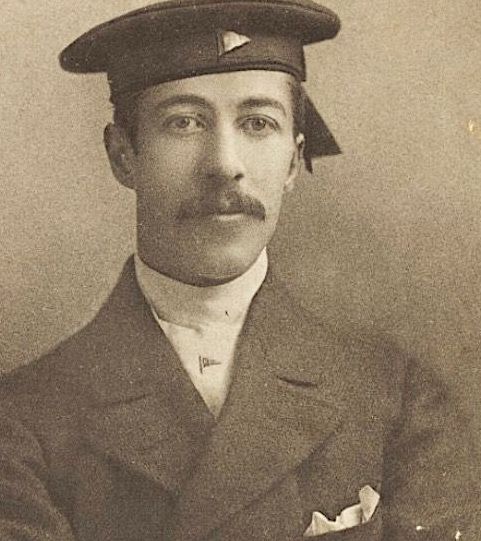
Henry Cyril Paget in his military days. Image via Public Domain.
When Paget’s father died on October 13th 1898 the then twenty-three year old inherited all of his family’s wealth. It was a massive fortune of approximately 30,000 acres in family estates valued at 81 million dollars in today’s money and an annual income of £110,000, an amount that today would be equal to 17.5 million dollars every year.
Being granted access to seemingly unlimited assets, Henry Paget 5th Marquess of Anglesey saw freedom and he quickly decided he was going to use this money to make himself happy, regardless of how contradictory it was to all expectations of him. Paget had a passion for the finer things and soon he was spending massive amounts of money on extravagant clothes, furs, jewels, cars, boats, perfumes, toys, chocolate, parrots, dogs, horses, and funding one of his great loves, theater. When his father died Paget renamed the family home of Plas Newydd, dubbing it Anglesey Castle, and proceeded to convert the family chapel into a 150-seat theater that he named the Gaiety Theatre.
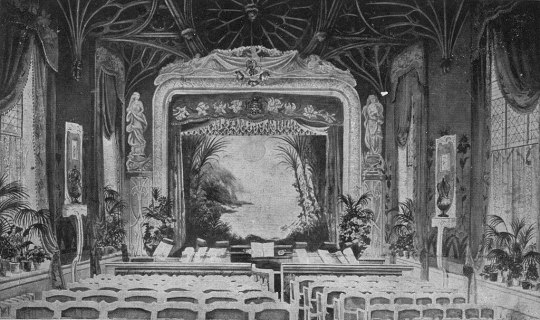
The converted Gaiety Theatre. Image via Wikipedia.
The productions at the Gaiety were just as extravagant as Paget. The programs given to attendees were designed in the shape of characters in the production and sometimes made from silk. The shows varied wildly and ranged from variety acts to Shakespeare with Paget often taking a lead role in the entertainment, sometimes performing dance numbers that earned him the nickname “The Dancing Marquess.” Eventually he hired a formal company of actors and for three years Paget took them on tour throughout Europe and Britain. While Paget may have felt he was living his true and best life, his wife completely disagreed with his lifestyle and by 1900 she filed for divorce.
If the separation from his wife affected him the Marquess did not let it on and he continued to spend his fortune like water. His collection of cars grew and he customized them as much as his clothing, fitting them so that the exhaust fumes would smell like rose perfume and the seats were revolving armchairs. He amassed a herd of thirty dogs and when he wanted an item of clothing to be a certain color he would cover it in jewels of that hue. One item in is wardrobe, a ping-pong jacket, was green in color because it was completely covered in emeralds.
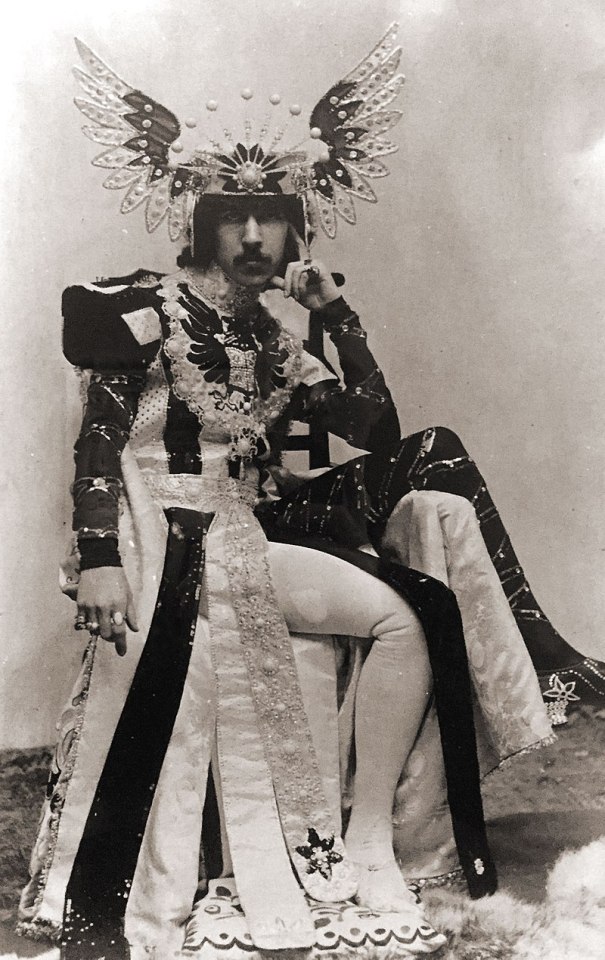
Henry Cyril Paget. Image via Wikipedia.
Despite presenting himself as an otherworldly figure, Paget was well known to the local community, often getting involved in events, charity work, and inviting them to his theater productions. Those who worked for him in Anglesey Castle enjoyed his company. But, the good will of those around him could not pay his bills and unbelievably, within six years, all of Paget’s money was gone.
With astronomical debts totaling tens of millions of dollars, the only thing that could be done was to sell the belongings that absorbed his fortune. Trustees of the estate began forty days of sales of his items. In one day alone they sold 900 lots of silk suits and fur coats.

Henry Cyril Paget circa 1900. Image via Wikipedia.
After the sale of his belongings Paget “retired” to France, traveling with a servant, a nurse, and a baby who was eventually returned to their biological parents. Despite burning through an unimaginable fortune, he was not totally financially cut off and he was allotted an allowance of £2,000 a year, an amount equal to just under $300,000 a year today. Even though he officially moved on from his home and underwent a bankruptcy, people did not forget about Paget and he remained in the public eye, giving interviews to newspapers and telling them “In six years, I have run through that fortune, just how - I could not tell you." In time Paget moved on to Monte Carlo where it was reported that he claimed to have invented a new type of gambling system. But, he never had the opportunity to see his plan come to fruition. Somewhere along his many journeys the Marquess contracted tuberculosis and on March 14th 1905 he succumbed to pneumonia. Henry Cyril Paget, 5th Marquess of Anglesey, passed away at twenty-nine years old. His ex-wife was at his side when he died.

Henry Cyril Paget. Image via bizarrevictorian.livejournal.com.
The reaction to Paget’s death ranged from mild sadness to utter disrespect at his squandering of his fortune and the tarnish he brought to his family name. Obituaries described a weak and bizarre man who was a waste of life. Stated one obituary: “From boyhood to death no one had ever loved him…[he was] a strange and repellent spirit opaquely incomprehensible and pathetically alone.” His remains were sent to St Edwen's Church on his Anglesey estate for burial.
Upon Paget’s death the title of Marquess passed to his cousin Charles Henry Alexander Paget who put a great deal of effort in erasing any memory of the man before him. He destroyed all records pertaining to his predecessor and converted the Gaiety Theatre back into a chapel. Desperate to put the honor back into their name, the family did what they could to move on and forget the seven-year reign of Henry Cyril Paget.
Plas Newydd remained in the possession of the Paget family until 1976, when it was donated to the National Trust. The house and gardens are now open to the public who are welcome to view the massive art collection housed inside. Despite the Paget family’s reluctance about their descendant, he is not completely omitted from the home he once dubbed his castle. Included in the display are a handful of black and white photographs of the 5th Marquess, dressed in all his bejeweled and extravagant glory.

Plas Newydd today. Image via Wikipedia.
#husheduphistory#featuredarticles#weirdhistory#forgottenhistory#bizarrestory#fancy#extra#BritishHistory#extravagance#luxury#truestory#livingyourbestlife#forgottenpeople#overlooked#historyisnotboring#historyiswild#historyclass#history#filthyrich#tragictale#sadstory#truthisstrangerthanfiction#theaterhistory#Wales#sparkle#unusualpeople#oneofakind#lavishlife
4 notes
·
View notes
Text
Maynooth’s Demon, Denial, and the Horror of Rhetoric House
In the 1840s much of Ireland was looking to God and begging for answers. Political turmoil and religious conflict collided with the Great Irish Potato Famine bringing immense suffering to the Irish people who seemed to be losing everything and everyone around them. To many young men, the priesthood could promise many positive things during a time of crushing uncertainty like a connection to divinity, the opportunity to help heal the suffering all over the land, and the ability to serve in their spiritual beliefs. For some, it was a way to guarantee a roof over their head and a meal on their plates. Laying just outside of Dublin is Maynooth’s St. Patrick’s College, the training grounds for Ireland’s Roman Catholic priests since 1795. The school was operating less than a century when it was suddenly marked with unexplained horror.

The outside of Rhetoric House at Maynooth (formerly known as Junior House). Image via comeheretome.com.
Not much is known about twenty-one year old Sean O’Grady before his arrival at Maynooth to study the priesthood. He was originally from Limerick and he was a fair student, attending to his studies and boarding in a small room in the residential hall called Junior House (later named Rhetoric House.) Within the first semester things began to change for the young student. The rules for priests-in-training were very strict and his mentors were not pleased to see that O’Grady was letting his studies slip, that he was not attending masses, and that he was increasingly absent for even the most basic requisites. One March morning in 1841 the Dean had had enough of the seemingly lazy student and he made his way up the stairs of Junior House, to Room No. 2, to confront O’Grady. When the door was opened the student was found slumped over on the floor. His sink was full of water, his hand grasped a razor, and the blood that poured from his slit throat was already soaked into the floorboards.
When Thomas McGinn took up residency in Room No. 2 many years later no one told him what history that room held or why it had been left vacant for so long before he was placed there. No one explained the stains on the floor, no one spoke the previous tenant’s name, and McGinn settled in for what he probably expected to be a year of hard study. It is unknown if the Dean or any of the faculty thought of the room’s previous occupant when McGinn began to complain of bad dreams, difficulty focusing, and a general feeling of doom enveloping him. If anyone thought of speaking to McGinn, they were too late. On an April morning in 1860 the quiet landscape of Maynooth was shattered when the student’s body crashed through the window and hit the ground so many floors below with a sickening thud. His bones were broken, he was holding a razor, and he was bleeding. But, he was alive.

A view of St.Patrick’s College, Maynooth. Image via wikipedia.com.
When Vice President of the school Dr. McCarthy visited the shattered man in the infirmary, he received a shocking explanation of what happened. There was nothing accidental about the fall, he threw himself out the window and toward almost certain death. The reason was not suicide, it was fear. McGinn told the Vice President that as he was shaving that morning, razor in hand, he looked up and saw a demonic face behind him urging him to cut his own throat. According to the student he felt a force take his wrist and he knew the only thing to do was escape. But, the only way out was through the window to the ground below. McGinn died of his injuries on April 21st 1860.
The authorities at Maynooth had an urgent decision to make about Room No. 2 of Rhetoric House. The school and church leaders needed to keep the happenings as hidden as possible. The two students were buried in unmarked graves in the on-site cemetery. But were there only two? There are differing accounts with some people claiming there was actually another student, one that took up Room No. 2 in between O’Grady and McGinn who was also found in the room with their throat slashed. There are additional accounts of a priest spending a night in the room after the death of McGinn. He refused to believe all the whispering about the “cursed” room and he wanted to prove once and for all that this was nothing more than a set of tragic and unfortunate coincidences. According to the story, whatever he experienced made him bang on the walls and howl in agony the entire night but left him silent the next morning, refusing to speak of what happened to him in the room of Rhetoric House.
What is known for sure is that on October 23rd 1860 the Trustees decided to convert the room to an Oratory of St. Joseph. The decision was fast and according to the October 24th 1948 issue of Irish Independent, there was no reason given for the conversion. The window that McGinn used to escape evil was walled off, an alter was built, and a statue of St. Joseph was placed. St. Joseph is the patron saint of a peaceful death.

Piece about the Maynooth “Ghost Room” appearing in Irish Independent on October 24th 1948. Image via comeheretome.com.
Room No. 2 of Rhetoric House underwent many changes in the subsequent years, utilized as academic office spaces and a waiting area between offices. Throughout all its incarnations the stories remained and the small room in Rhetoric House began to attract some possibly unwanted attention. In 1998 renowned paranormal researcher, author, and parapsychologist Hans Holzer included the seminary in his book Hans Holzer’s Travel Guide to Haunted Houses and his account of visiting the infamous Room No. 2 with psychic medium Sybil Leek appeared in his book This House is Haunted.
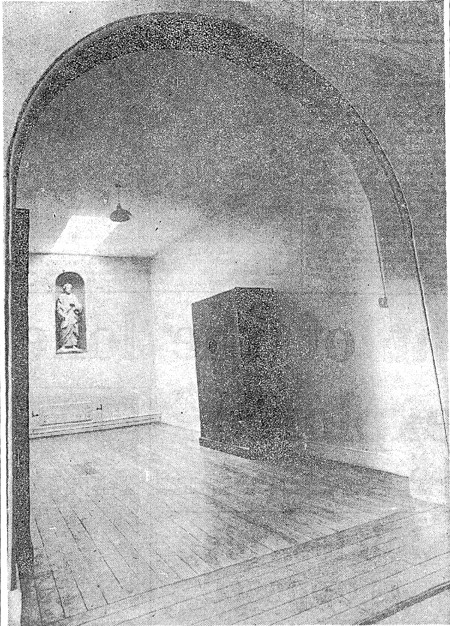
An image of the room as it appeared in 1978 from the Irish Independent June 25th 1978. Image via comeheretome.com.
Today the stories of “The Blood Room” of Maynooth are still spoken, helping the college to earn the dubious distinction of one of the most haunted locations in Ireland. The locations tied to the stories are all still there and out in the open. The stones in the cemetery placed for Sean O’Grady and Thomas McGinn stand without their names and the window where McGinn fell can still be seen from the outside of the building, easily identified as the window that has a blank wall behind its glass. A large bronze plaque names all the deceased buried at Maynooth and among them can be found the names Sean O’Grady and Thomas McGinn. The main goal for visitors though, is to set foot inside Room No. 2 itself. Mostly empty today, the room stand silent with the alter and St. Joseph still watching over the space. Take note though, visitors to the room are forbidden to bring mirrors inside.
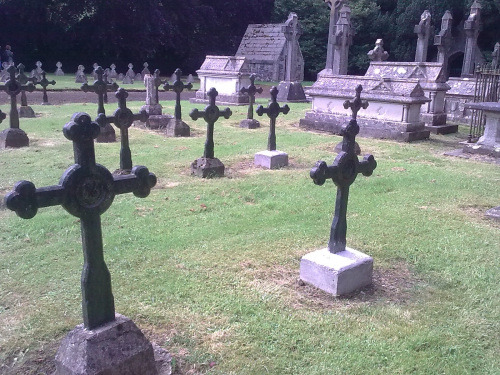
The crosses with no names thought to be the final resting places of Sean O’Grady and Thomas McGinn. Image via comeheretome.com.
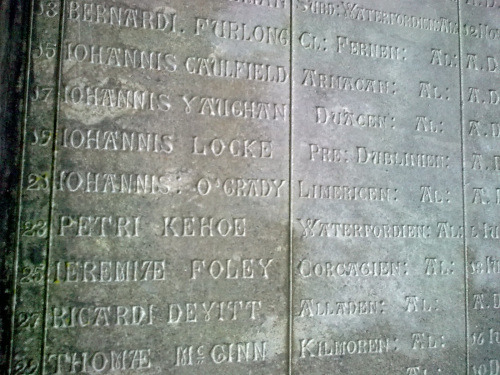
The names of the deceased of Maynooth. Image via comeheretome.com.
On the floor is a large, old, dark stain. Allegedly tested by the school’s Chemistry department and proven to be human blood, the stain is sunken deep into the wooden floorboards, refusing to move after every attempt at removal over the last 160 years.
********************
Sources:
https://comeheretome.com/2012/07/20/the-ghost-room-in-maynooth/
https://soundcloud.com/ghost-maynooth/maynooths-ghost-room
https://www.cultofweird.com/paranormal/maynooth-ghost-room/
#HushedUpHistory#featuredarticles#Ireland#IrishHistory#paranormal#paranormalhistory#Maynooth#unexplained#historicbuildings#historicschool#scarystory#scaryhistory#creepyhistory#forgottnehistory#weirdhistory#horrorhistory#historyisnotboring#demonichistory#unsolved#mystery#coverup#creepy#whathappenedhere#haunted#HauntedIreland#Irishhaunting#terrifyingstory#stillthere#history#historyclass
7 notes
·
View notes
Text
“Tiger Woman” and her Trunks: The Horrible Case and Cargo of Winnie Ruth Judd
It is difficult to imagine what was going through Ruth’s mind when she arrived at the train station on October 19th 1931. She was only twenty-six years old but she had lived in numerous states, moved to Mexico, had her marriage fall apart, reestablished herself in Arizona, and was beginning a new life. But now, she was unexpectedly in California to meet her brother with a bandaged hand and a lot of luggage to pick up. When she arrived at the Los Angeles train station the baggage agent refused to let her pick up her trunks until they could inspect the contents. She informed them she did not have a key and that she would come back for them later. She never went back. Within a matter of days she was given many new names, became the subject of a manhunt, and surrendered herself to police inside a funeral home. The story was shocking, but it was far from done.

Winnie Ruth Judd.
Born on January 29th 1905 in Oxford, Indiana, Winnie Ruth McKinnell (who went by Ruth) was only seventeen when she married Dr. William C. Judd, a World War I veteran who was twenty-two years her senior. Dr. Judd was a morphine addict and his pursuit of a steady job brought the pair to Mexico where he worked as a medic for an American mining company. By 1930 the two were living apart and Ruth returned to the States by herself looking for a place to call home. What she found was Phoenix, Arizona and a job working for a wealthy governess. It seemed that Ruth had finally left the troubled times behind and was on her way to forging a new life. Then she met Happy Jack.
John J. “Happy Jack” Halloran was very well known in Phoenix. At forty-four years old he made a name for himself running an extremely lucrative lumber business and with his success came friends in high places. Both he and Ruth were married, but that did not stop the two from igniting a relationship and Ruth soon found two new friends during their alcohol-infused parties with Halloran’s associates. Agnes “Ann” Leroi was thirty-two years old, twice divorced, and was working as an x-ray technician. Her partner, Hedvig ‘Sammy” Samuelson, was twenty-four and the pair had moved to Phoenix from Alaska after Sammy’s battle with tuberculosis. Ann and Sammy lived together in a small three-room bungalow and it wasn’t long before Ruth moved in, cementing the house as thee location for Halloran and his drinking buddies’ parties and card games. After several months Ruth moved out and got her own apartment, but the three women remained best friends. On the night of October 16th 1931 Ruth went to visit the two friends for dinner and drinks. Ann and Sammy were never seen alive again.

“Happy Jack” Halloran. Image via the Arizona Memory Project https://azmemory.azlibrary.gov/
Three days later in Los Angeles the train station baggage handler was waiting for Ruth to come back and open her luggage for inspection, but he couldn’t wait anymore. The luggage was leaking, it smelled horrific, and there were flies gathering around them. He was convinced she was smuggling deer meat and he called the Los Angeles Police Department. When the police arrived and opened the luggage out tumbled the body of Ann Leroi and three sections of what was once Sammy Samuelson. When Ruth was picked up by her brother he had no idea what his sister was hiding, he dropped her off somewhere in the city and she vanished.
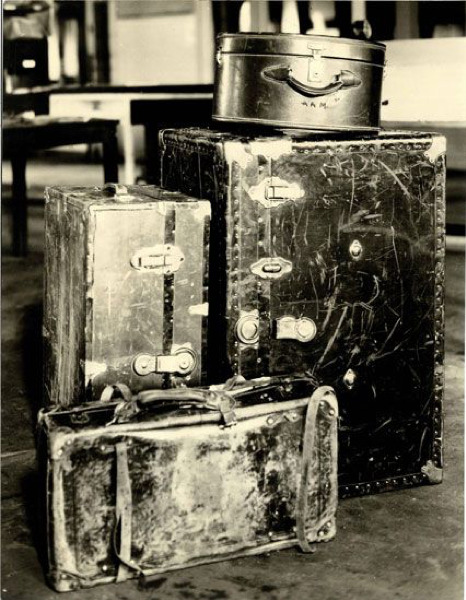
The luggage that contained the remains of Ann Leroi and Sammy Samuelson.
The headlines exploded with the horror story, screaming “TWO WOMEN’S BODIES SHIPPED HERE IN TRUNKS BY FIENDISH KILLER!” and dubbing Ruth with names like “The Blonde Butcher”, “The Tiger Woman”, and “The Trunk Murderess.” Back in Phoenix the owner of the bungalow didn’t waste a moment and immediately placed ads in the local paper offering tours of the crime scene for ten cents. The frenzy raged on for four days before Ruth finally turned herself in to the police on October 23rd.
The question on everyone’s mind was what could have caused anyone to kill their two best friends and shove their bodies into luggage, but it was a question that was difficult to answer. By the time the police were able to investigate the crime scene the house had already had thousands of people walking through it and one mattress was inexplicably missing. Ruth released a statement through her attorney explaining her version of the story. According to her account, she visited the two women for a nice evening but ended up getting into an explosive argument with Sammy. Her account goes on to claim that Sammy:
“got hold of a gun and shot me in the left hand, Mrs. LeRoi grabbed an ironing board and started to strike me over the head with it. In the struggle, I got hold of the gun, and Sammy got shot. Mrs. LeRoi was still coming at me with the ironing board, and I had to shoot her. Then I ran from the place.”
Then came another shockwave, Ruth said she fled to her apartment where Jack Halloran was waiting. She claimed he returned to the house with her and it was he who cut up Sammy and shoved the bodies in the luggage while she cleaned up the bloody scene.
The story was a sensation, but it did not overly make sense. The police and medical examiners at the scene determined that the women were shot in the head at close range while laying in their separate beds. The location of the injuries did not match with gunshots fired during a fight, especially a fight involving three people, one of which was holding an ironing board. Another question swirled in the minds of Phoenix, why was Halloran waiting at Judd’s apartment and why did he help her dispose of the bodies of their friends?

Newspaper reporting the discovery of the bodies in the trunks.
The trial of Ruth Judd began on January 19th 1932 and from the beginning Judd claimed she only shot Ann and Sammy in self defense. Amazingly, she was only tried for the murder of Ann, and the court did not buy her story. In the eyes of the court the tension between the women was evident for weeks, beginning with Judd moving out of the house they shared. The theory was that the source of the bitterness was venomous jealousy over Halloran’s affection for the other women and that Judd went to their house that night with the intent to kill. On February 8th 1932 Judd was found guilty of first degree murder and sentenced to death by hanging.
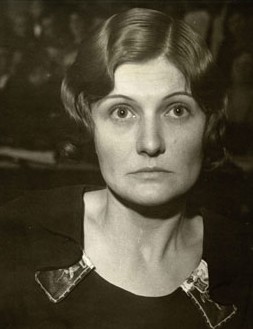
Judd at her trial in 1932.
Judd was not the only person defending herself in court over the gruesome crime. When Halloran’s name was brought into the story he too was eyed for his involvement in the bloody scene. On December 30th 1932 he was indicted by a grand jury as an accomplice to murder, and Judd was the star witness against him. In Judd’s testimony she told the story of how she got into a fight with Sammy over her introducing Halloran to another woman. She then shot them in self defense, met Halloran at her apartment, and it was he who dismembered Sammy, dragged in the luggage, packed the bodies into a single large trunk, and made her promise to tell no one. Even though Judd admitted to the shooting and later unpacking and repacking the bodies in different pieces of luggage so they were easier for her to manage, she insisted that Halloran was just as guilty as she was. She stated in court “I am going to be hanged for something Jack Halloran is responsible for ... I was convicted of murder, but I shot in self-defense. Jack Halloran removed every bit of evidence. He is responsible for me going through all this. He is guilty of anything I am guilty of.”
Halloran’s lawyers argued that since Judd said the women were killed in self defense there was no crime to charge their client with. And besides, she was obviously insane. The charges against Halloran were dismissed on January 25th 1933. He may have been found innocent in court but he never regained his beloved image in Phoenix, losing his business and most of his associates.
Judd’s execution was scheduled for February 17th 1933 but only days before she was supposed to die Arizona authorities changed her sentence. Following a huge outpouring of people who believed that Judd was mentally unsound and should not be put to death she was instead committed to the Arizona State Mental Hospital, beginning her stay there on April 24th 1933.
Everyone assumed that Judd would live the rest of her days behind the walls of the hospital, but they were wrong. On October 24th 1939 she constructed a dummy out of boxes and towels, arranged it under her blankets, and escaped from the hospital. She was at large for six days before she was caught and brought back but Judd was able to escape six more times. Her last escape took place on October 8th 1963 when she simply walked out the door, a friend inside the hospital had given her a key. Most of her previous escapes only lasted a few days but this time was different. Judd somehow ended up in the San Francisco Bay Area and formed an entirely new identity. Living as “Marian Lane” she worked as a live-in housekeeper in a mansion owned by an elderly woman for seven years before her true identity was discovered and she was again arrested. Considering she was able to escape multiple times and resume a “normal” life outside, she was then judged sane by medical examiners and relocated to the state penitentiary where she remained until she was released in late 1971. When released Judd made her way back to California where she again took up the name “Marian Lane” and she went on to live a quiet life until her death in 1998 at the age of ninety-three.

A nurse holds up a rope used by Judd in her 1952 escape. Image via azcentral.com.
Although Judd was found guilty of first degree murder in 1932 the reason for the killings was never crystal clear. In 2014 a letter was discovered in the Arizona State Archive. It was dated April 6th 1933, it was handwritten by Judd, and it states that it is her “first and only confession.” In the text of the letter Judd details the murders of Ann and Sammy, claiming she was pushed to kill by the incessant “taunts” of Ann Leroi who tormented her by flirting with Halloran. She states: “Those taunts kept me awake, I could not sleep. I cried. I even prayed. I was losing my mind…No human was ever going through so much turmoil of mind.”
According to Judd, on the evening of October 16th with her “brain whirling” with “insane thoughts” she “got up and went over to Ann’s house,” carrying her .25-calibre handgun. Both women were asleep and she snuck in through the front door, deciding to sit down on the couch where she eventually fell asleep. She was woken up by Sammy walking into the bathroom and she then remembered what she “had come to do.” She moved toward the bedroom but turned away because she was “shaking inside.” Returning to the couch she fell back to sleep. She was woken up by the sound of the milkman outside and when she realized Sammy was again in the bathroom she got up, went into the bedroom, and shot Ann in the head. Hearing the gunshot Sammy rushed into the bedroom and tried to wrestle the gun from Judd, accidentally shooting her in the hand. Judd then claims they both fell on the floor, “and I finally got the gun and in my wild state I shot her in the head.”
After both her friends lay dead Judd went into the garage, pulled a large trunk into the house, and stuffed Ann’s body inside. Then, Judd went to work and carried out a normal day. According to her letter, she had nothing planned out other than killing Ann, “I really had nothing definite in my mind. No plans made. In fact except for an irresistible impulse to get Ann I had no other plans.” After a brief trip to her apartment after work she returned to the scene of the crime and got inside through a bathroom window. She attempted to fit Sammy in the trunk but “that was utterly impossible, I couldn’t possibly lift her, she was too heavy and her body was stiff. I then got two cheap knives from the kitchen and severed her body into portions I could lift.” She then shoved the pieces of Sammy into a smaller trunk and a suitcase.

Ann Leroi and Sammy Samuelson. Image via azcentral.com.
Those who only knew “Marian Lane” in California probably had a very difficult time reconciling the person they knew with the Winnie Ruth Judd from Phoenix. She was a little old lady who always had a friendly smile and her hair done, a hugely far cry from the “Trunk Murderess” that filled the headlines decades before. She never fully denied her past though, once commenting “how she was sorry she wasn't going to live long enough to see the day when people would finally stop remembering Winnie Ruth Judd.”
Today, the bungalow where the murders of Ann Leroi and Sammy Samuelson took place still stands in Phoenix at the corner of Second Street and Catalina Drive. It was recently purchased by someone who hopes to restore it to show what it looked like the night of the infamous Trunk Murders.
You can read the full confession of Winnie Ruth Judd here.

A 2010 photograph of the Trunk Murders bungalow. Image via Wikipedia.
*********************************************************************************
Sources:
The Arizona Memory Project https://azmemory.azlibrary.gov
The Yale Review yalereview.yale.edu/trunk-murders-1931
AZCentral.com
Read More:
The Trunk Murderess: Winnie Ruth Judd by Jane Bommersbach
#husheduphistory#featuredarticles#history#Arizona#ArizonaHistory#California#CaliforniaHistory#truecrime#CrimeHistory#infamous#crime#horror#tragictale#rip#tragichistory#sadhistory#horrorhistory#historyisnotboring#shocking#truestory#truestories#infamousmurder#trunks#trunkmurders#truefacts#Legalhistory#insanity#unexpectedtwist#friendsnomore#whatisthetruth
1 note
·
View note
Text
Long Before Lizzie: The Many Misfortunes of Great-Uncle Borden
The New Bedford Superior Court was buzzing with anticipation. For nearly a year Lizzie Borden sat in a prison cell, accused of murdering both her father Andrew and step-mother Abby and she was finally in court to face the horrific charges against her. The accusation was bad enough, but the method was shocking. Andrew and Abby were hacked to death in their home by an ax, and their daughter was the number one suspect. The evidence against Lizzie was strong. The tension in the house was high and she was known to have a very difficult relationship with her parents, leaving the home after an argument and staying in a rooming house until returning to the Borden home a week before her parent’s deaths. The prosecution claimed that in the weeks leading up to the murders she tried to buy Prussic acid but was unable to secure any. She also burned a dress shortly after the murders claiming she needed to destroy it because it had paint on it. Among everything brought up by the prosecution there was one incident in particular that may have dug up bad memories for anyone familiar with the Borden family.

Illustration of Lizzie Borden during her trial.
Image via By B.W. Clinedinst - https://commons.wikimedia.org/wiki/File:BW_Clinedinst,_the_Borden_murder_trial_cph.3c23237.jpg, CC BY 3.0, https://commons.wikimedia.org/w/index.php?curid=71387462.
Lawdwick Borden was born on March 14th 1812, the son of Martha Patty Bowen and Richard Borden. On September 8th 1833 Borden married twenty-two year old Maria Briggs, but the union was quickly marred by tragedy. By 1836 their two infant children died and two years later they were followed by their mother who passed away in 1838 leaving Lawdwick a widower at twenty-six years of age. On March 16th 1843 he married his second wife, Eliza Darling.

Image showing the home of Lawdwick and Eliza Borden. Image via https://lizziebordenwarpsandwefts.com/
Lawdwick and Eliza lived in a small Cape Cod style home located on land owned by the Borden family in Fall River, Massachusetts. After all of the tragedy in his past, Lawdwick may have had high hopes for his new life with Eliza and on October 22nd 1844 they welcomed a daughter named Maria. Their second daughter, Eliza, arrived in 1846 and she was followed by a son named Holder in 1848. Lawdwick’s first marriage ended in tragedy after five years during which he saw the death of two children and his wife. He had no idea it was about to happen again.
In 1848 Eliza Darling Borden committed the unthinkable. Taking her two year old daughter and infant son into the cellar of her home, she threw the children into a cistern where they both drowned. There are two main variations of where Eliza went next, some say she went upstairs and other say she went behind the chimney in the cellar. Regardless of the exact location, the outcome was the same. Eliza slit her own throat with one of Lawdwick’s straight razors joining her two young children in death at the age of thirty-seven.

The grave of Eliza Borden. Image via findagrave.com.
Lawdwick and Eliza’s youngest daughter Maria survived the ordeal and Lawdwick went on to marry his third wife, Eliza T. Chase on February 29th 1856. Although this third marriage lasted longer than the previous two, in 1865 Lawdwick buried another wife when this Eliza died at fifty-one years old. At this point he had buried three wives and four children all before the age of fifty-three.
Just after little Maria Borden was born in 1844 another house was built on land owned by Lawdwick. Just next door and slightly north of the home where Eliza would eventually take the lives of her two younger children and herself a home was built on 2nd Street for woolen mill carding room supervisor, Charles Trafton and his wife Hannah. By 1851 Charles would lose both his wife to tuberculosis and his infant son Charles Jr. to unknown causes inside the house. Charles and his second wife lived in the home until 1872 when Lawdwick’s nephew and his family moved into it. His nephew was Andrew Borden and he and his wife Abby were killed in Trafton’s house, now the infamous Lizzie Borden house on August 4th 1892. Adding to the bloodshed, after speculating if the two had been poisoned previous to the ax attack their bodies were taken into the dining room of the house, laid out on the dining room table, and their stomachs were cut out for examination.

The Lizzie Borden house in the late 1800s. Image via wikipedia.org.
By the time Lizzie Borden stood in the courtroom accused of murdering her father and step-mother with an ax the name Borden had already had more than it’s fair share of tragedy. During the trial the mental state of the entire Borden family was brought up with a particular focus being put on the suicide of Eliza Borden after drowning her two children. As much as the prosecution wanted to use the tragic deaths as evidence of “inherited madness” it was almost immediately shut down. The defense correctly argued that Eliza was only a Borden by marriage, not by blood. And besides, the surviving child Maria was now forty-nine years old and “alive and well and a mother herself still living in the city.” It was a valuable point to make, and one that may have helped Lizzie walk out of the courtroom as a free woman on June 20th 1893.
When mentioning Fall River, Massachusetts many minds will automatically go to the horrific murders that happened on 2nd Street that hot August morning of 1892. What is discussed far less is that the land where the bloodbath took place was owned by a family member of Lizzie’s that had already seen unspeakable tragedy long before the ax came down on Andrew and Abby. When Lawdwick Borden died on October 6th 1876 he was sixty-two years old and in that time he lost four young children, two of which were murdered by their mother who slit her own throat with one of his razors. Before Andrew and Abby even moved into the house where they would be killed and dissected there were already at least two deaths behind the doors situated on Lawdwick’s land.

The Lizzie Borden house in 2019. Image via wikipedia.org.
The Borden family history was cemented in bloody infamy with Lizzie, but decades before she was born another Borden, her great-uncle Lawdwick, saw horror come to the name through unrepentant death, drownings, disease, and straight razor suicides.
******************************************************************
Sources:
lizziebordenwarpsandwefts.com/
findagrave.com
http://www.murderbygaslight.com/2020/01/
https://www.biography.com/news/lizzie-borden-life-after-murder-trial
https://bostonghosts.com/eliza-borden-and-the-children-in-the-well/
#HushedUpHistory#featured articles#MassachusettsHistory#TrueCrime#LizzieBorden#FallRiver#FamousCrime#FamousMurder#CrimeHistory#truestory#weirdhistory#forgottenhistory#strangehistory#truth is stranger than fiction#historyclass#horrorstory#horrorhistory#scaryhistory#historyisnotboring#cursed#tragictale#darkhistory#scarystory#sadhistory#yikes
1 note
·
View note
Audio
Hushed Up History turns SIX years old today!!!
To mark this momentous event, travel back with us to the first story we ever posted. But this time, the words are spoken.
Enjoy! Happy Halloween!
#HushedUpHistory#featuredarticles#history#forgottenhistory#strangehistory#weirdhistory#darkhistory#historyclass#Englishlanguage#OxfordEnglishDictionary#unexpected#truestory#historyiswild#historyisnotboring#truthisstrangerthanfiction#newpackaging#newformat#flashback#shortstory#true stroy#dictionary#words#madman#audio#surprise#unknown#Halloween#HalloweenBirthday#HappyHalloween
1 note
·
View note